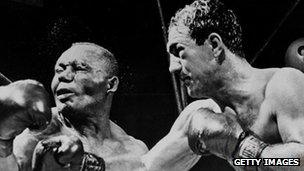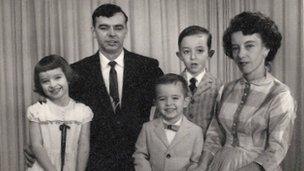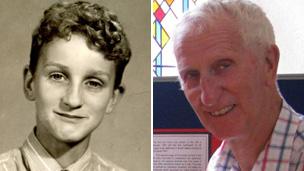Swansea memorial to American D-Day veterans
- Published
A memorial has been unveiled in memory of the thousands of American soldiers who lived and trained across Swansea in preparation for the D-Day landings.
For a few months in 1943 and 1944, GIs from across the Atlantic set up camp in Mumbles, Caswell Bay and Newton.
Combat engineers took part in training for the beach landings in northern France.
The memorial was unveiled at Newton Village Hall.
There were about 50,000 US soldiers in south Wales before D-Day on 6 June 1944 - a pivotal moment of World War II.
The training on the south Wales beaches was seen as vital for the 42,000 troops who left the Bristol Channel ports, with more than 6,000 vehicles, for Normandy.
Charlotte Dubenskij talks to residents who remember the Americans
Villager Betty Sivertsen, who was 18 in 1943, said: "They were really very nice boys but they were missing their homes terribly."
"They made friends with one or two people but they certainly worked them hard - they were out on manoeuvres all the time."
She said the GIs shared their rations, while villagers shared their home comforts.
"They came around to have baths, they'd bring something with them - teas, sugars, that sort of thing."
John Powell, of Oystermouth Historical Association, said: "It seemed every young boy at the time was fascinated with them.
"They helped an awful lot in supplying Hershey bars, chewing gum ... they knew how necessary it was to drop the tins of chicken and stewing steak which they seemed to be well supplied with.
"The local boys found the tanks, floating trucks and Jeeps, all the military paraphernalia fascinating."
Boxing legend
Among GIs training in Swansea was future boxing champion Rocky Marciano, then 20 and a raw recruit.

World heavyweight champion Rocky Marciano (right) was a soldier in Swansea
Larry Owen, eight at the time, said: "There was a famous story during the war that Rocky Marciano was in the Adelphi pub in Wind Street.
"An Australian sergeant got rather aggressive and Marciano, who was very quiet apparently, put him to the wall."
The story goes that the young boxer was taunted for not drinking alcohol.
In an interview about the fight, the world heavyweight boxing legend recalled: "The Aussie finished up in his warm beer.
"The pub was called Adelphi - I wrote the name down just in case the Aussie had anything to say about the matter."
Some found love instead.
Glamour
Doreen Marley, from Swansea, became a GI bride and moved to Arizona after meeting her future husband Duane Heath.

Doreen Heath nee Marley with husband Duane and their children on a visit to Swansea in 1959
She met him through a friend and after the soldiers shipped out they kept writing before eventually marrying in Washington state after war ended.
"He was very friendly, with dark hair and brown eyes," she said.
"He was a good talker - he was perfect."
Glenn Booker, an historian of the GIs in south Wales, external believes the Americans had a profound impact upon the local population leading to as many as 1,000 marriages.
"Young ladies were impressed by their glamour and their manner," he said.
"Young British males might see them as love rivals so were not so keen.
"The older generation might have been wary of them at first but warmed to them as they got to know them. Many middle aged women saw them as sons far from home needing a home-from-home."
However, not all made it through the war and that is reflected in the memorial's inscription: "We will remember those who made the ultimate sacrifice for our freedom on the long road to victory".

Larry Owen remembers the GIs when he was a boy
Mr Owen said the memorial was important.
"They were young lads who came over far from home and were homesick," he said.
"But I found them very generous and friendly. I was sad there was no memorial, no indication they had ever been there."
As well as the unveiling, a service was held in Saint Peter's Church, Newton, conducted by the Right Reverend John Davies, Bishop of Swansea and Brecon.
- Published3 November 2012
- Published2 November 2012